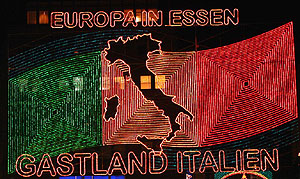Essen Lichtwochen

Fifties
The local daily newspapers proudly report that customers storm Essen's city centre during the pre-Christmas period. At times the main shopping streets have to be turned into one-way roads for the pedestrians as to cope with the crowds. Public transport does special trips. The Essen Lichtwochen (light weeks) are immensely popular for the people after the dark war times. The Lichtwochen have a annually changing theme since 1955: The Gruga, Essen's great garden exhibition determines this year the picture of the illuminated city centre. The Arabian Nights shine fairytale like in the following year 1956. In 1957 the motto is Europe's streets.
Sixties
The Lichtwochen bring in this decade economical growth from a mining industry city changing into a service metropolis, attributable through further soaring visitor figures. The themes of the light show deal with sportive or cultural events but also politics and upheavals of this epoch. In 1962 the theme is Olympics of lights, then in 1964 Berlin yesterday and today. The then ruling mayor of the separated city Berlin, Willy Brandt, opens the Essen Lichtwochen personally as a thank you to the Essen people. Today a central place in the city centre is named after.
Seventies
The Lichtwochen stayed contemporary: In 1970 they show the path of the Apollo 11-crew to the moon. The light shows show at the beginning of the 70ties the start of the fitness-wave with the motto Keep Fit. Then the energy consumption of the Lichtwochen is being discussed as the show falls into the times of the oil crisis and Sunday driving ban. But the organiser are able rebut the arguments with a good energy record. In these economical hard times one uses consciously funny motifs: In 1977 the motto is Max and Moritz, in 1978 Loriot's Wum and Wendelin shine and in 1979 children paint the models for the light structure.
Eighties
In 1983 the campaign A Heart for Children becomes the good cause of the Essen Lichtwochen. In 1987 the motto Suuuch a Theatre is dedicated to stage happenings. Then local themes as for example the building of the Aalto-Theatre are being turned into illuminated motifs. 1989 feiern die Essener Lichtwochen 40 Jahre Bundesrepublik. Dass der Mauerfall am 9. November die Geschichte allerdings stark verändern wird, kann zur Eröffnung der Traditionsshow noch niemand ahnen...
Nineties
One discovers that the by now traditional Essen Lichtwochen are ideal to promote anniversaries like 500 years postal services. Fitting for the meeting of the 15 European states and prime ministers, who meet at the Essen Gruga Hall for the European Summit, the motto is in 1994 of course Europe in Essen. On the occasion of the "Essen Motor Show" at the trade fair Essen in 1997 three-dimensional light sculptures with illuminated tubes and pipes are being used for the first time. But one year later the Lichtwochen go back to their tradition: Lots of light bulbs show Essen trademarks from culture and economy. The 50th jubilee of the Lichtwochen is reason enough to celebrate oneself in 1999.
Since the turn of the century
The Lichtwochen devote themselves now to the EU, which has become a reality. From now on the motto Europe in Essen is in the foreground. Every year a new host country of the EU will be presented on large-sized illuminated walls. It was The Netherlands in 2001, Great Britain in 2002, then Finland. 2004 was given to the new EU member Poland. 2005 was dedicated to Italy. The logo showed a depiction of Rome's Colosseum in the Italian national colours green, white and red. Fringe events with culture and folklore from the host country accompany every event.
Picture Copyright : http://de.wikipedia.org/wiki/Bild:Lichterwochen2005.JPGThis article is based on the article from http://de.wikipedia.org/wiki/Essener_Lichtwochen the free Encyclopedia Wikipedia and can be found under http://de.wikipedia.org/wiki/GNU-Lizenz_f%C3%BCr_freie_Dokumentation . In Wikipedia is a http://de.wikipedia.org/w/index.php?title=Essener_Lichtwochen&action=history available.

